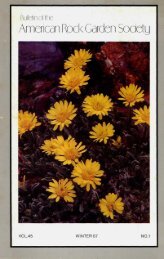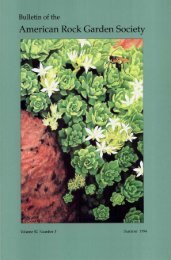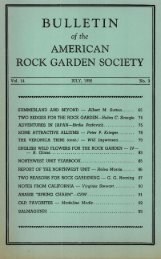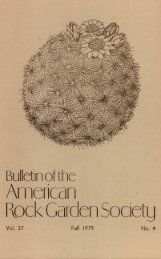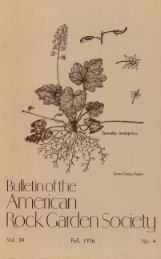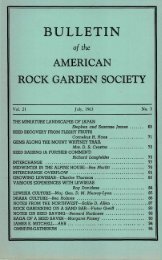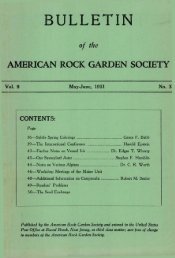Bulletin - Summer 1979 - North American Rock Garden Society
Bulletin - Summer 1979 - North American Rock Garden Society
Bulletin - Summer 1979 - North American Rock Garden Society
Create successful ePaper yourself
Turn your PDF publications into a flip-book with our unique Google optimized e-Paper software.
in the history of the genus N omocharisand its consequent retention in cultivation.I am sure that I speak forall growers of these wonderful plantswho firmly believe that, if all else fails,Edinburgh and that select group ofastounding Scottish growers can becounted on to keep things going. Taxonomically,Edinburgh has been in theforefront, with many reviews andpapers on the genus emanating fromthere.Pere Jean Marie Delavay (1834-1895) was a priest in the French MissionsEtrangeres and from 1867 untilhis death in 1895 lived in China. Hewas stationed in northwestern Yunnanbetween Tali-fu and Lichaing. Workingmostly alone, he sent a most remarkableamount of material back to France,to the extent that some fifty years afterhis death his herbaria were still beingsorted and classified. It was to Franchetat the Paris Museum that Delavay sentthe first known collection o fN omocharis. This was classified as N.pardanthina. Delavay collected N. pardanthinain June 1883 in the pasturesof Mount Koua-la-po in the Tali district,Yunnan Province. However, it is toGeorge Forrest that we are indebtedfor its introduction into cultivation. Itfirst flowered at the Royal Botanic <strong>Garden</strong>,Edinburgh in 1914 from seed thathe had sent back. Frank Kingdon Wardalso collected and sent back seed. N.pardanthina ranges in height from eighteento thirty-six inches with whorledfoliage. The flowers tend to be nodding,about three inches across, white or flushedwith the palest pink, the innersegments fringed whilst the outer areentire. The face is quite heavily spottedcrimson towards the center, giving theeffect of an eye. The filaments areswollen from their base to a little overhalf way up, after which they becomerapidly reduced, becoming thread-likebefore attaching to the anther. Thisswelling is quite unlike anything inLilium.N omocharis farreri is sometimes givenas a variety of N. pardanthina,which it quite closely resembles.However, N. farreri is reputed to growmuch more strongly, to have narrowerleaves, and the inner segments of theflower are not so heavily fringed, beingonly nicked. Plants that I have grownfrom seed under this name did notshow these characteristics. N. farreriwas first found by Farrer in the HpimauPass. Upper Burma in 1919 (Burma-YunnanBorder Region). It waslater collected by Forrest and by Ward.NemocharisapertaNomocharis aperta is another Forrestintroduction. He collected N. apertasometime in 1906 in southwesternSzechuan and northwestern Yunnan.This is rather a distinct plant withthe segments entire and the perianthof a flat saucer shape. The more orless outward facing flowers are threeto four inches across, white or flushedrose with blotches of deep crimsonaround the nectaries. The filaments arenot swollen. Although this species isreported to attain thirty inches, withme it tends to be rather short, growingsome eighteen to twenty-four inches tall.118



